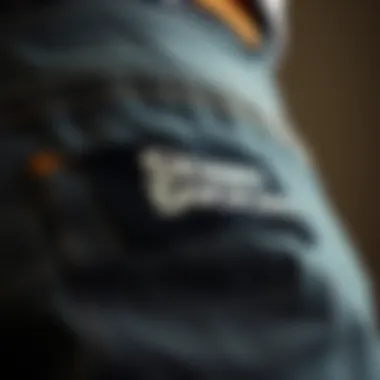The Impact of Skinny Dickies on Skate Culture


Intro
Skinny Dickies have carved a niche in skate culture, blending functionality with an unmistakable style. For many skaters, the right pair of pants doesn’t just serve a purpose; it tells a story and represents a lifestyle. The allure of skinny Dickies is not merely the snug fit or the iconic brand; it encompasses a deeper connection to the skateboarding community and the performance needs of those who ride.
As we explore this topic, we’ll take a closer look at how skinny Dickies emerged as a staple in skate fashion and how their design aligns perfectly with the demands of skaters. With insights into both the operational aspects of skating techniques and the evolution of skate culture itself, we aim to understand why these pants have become more than just clothing—they've become a part of the identity of a culture.
Skateboarding Techniques
Understanding the link between what skaters wear and how they perform on their boards can inform everything from product design to personal style choices.
Essential Tricks for Beginners
For those just starting their skateboarding journey, mastering the basics is key. Here are some fundamental tricks that aspiring skaters typically learn, which can help shape their progressive skill set:
- Ollie: The foundational move that enables skaters to jump and clear obstacles.
- Kickflip: A step up from the ollie, where the skateboard flips in the air.
- Pop Shuvit: An impressive maneuver involving the skateboard rotating under the rider's feet.
These tricks require flexibility and movement, making the choice of pants critical. Skinny Dickies, with their tailored fit, allow for a full range of motion without the fabric getting in the way, ensuring that skaters can make those quick movements required to nail their tricks.
Advanced Maneuvers for Seasoned Skaters
As they progress, many skaters seek to push their limits. Let's consider some of the challenging tricks that bring further excitement to their riding experience:
- Heelflip: A variation of the kickflip, executed by flicking the board with the heel.
- Blunt Slide: A trick that necessitates sliding the tail of the skateboard along a ledge or rail.
- 540 Spin: A complex maneuver designed to impress both peers and onlookers.
Mastering these tricks demands not only skill but also the right gear, where skinny Dickies shine. Their durable fabric and street-smart aesthetics mean that skaters can practice intensely without worrying about wear and tear.
Skate Culture
The world of skateboarding extends beyond the tricks and techniques; it's enriched by a vibrant culture.
The Evolution of Skateboarding Styles
From the days of simple wooden boards to the intricate designs and graphics today, skateboarding style has evolved remarkably. Originally rooted in surf culture in the 1950s, the sport adopted urban influences by the 1980s and 90s. Skinny Dickies play a significant role in this journey, reflecting the desires of a generation for both style and function. The way skaters adorn themselves reflects their individuality, often blending elements of punk, hip-hop, and even high fashion.
Community Engagement and Local Events
The skate scene thrives on community. Local skate parks often host competitions and events where skaters showcase their skills and connect with one another. Skinny Dickies have become a uniform of sorts, representing camaraderie in the face of adversity and celebration of creativity. People look to local legends, aspiring skateboarders, and skate influencers who often choose these pants as part of their attire, influencing upcoming generations.
In essence, understanding the physical requirements of skateboarding, alongside the culture that supports it, lays the groundwork for comprehending why skinny Dickies stand tall among other apparel options within this community.
"The skateboarding scene is not just about riding; it's about shared experiences and the threads that bind us together."
By delving into both the style and practical elements of skinny Dickies for skaters, we see a rich tapestry of function intertwined with identity.
Understanding Skinny Dickies
When we talk about skinny Dickies, it's not just about a pair of pants; it’s about a distinctive cultural emblem that resonates deeply within the skateboarding community. These trousers, characterized by their slim fit and tough fabric, prove to be more than a mere fashion choice. For skateboarders, they are a blend of practicality and a representation of identity. The importance of understanding skinny Dickies is paramount, as it sheds light on their role in aiding performance, durability, and how they blend seamlessly into the aesthetics of skate culture.
Definition and Characteristics
Skinny Dickies, particularly tailored in a form-fitting style, were originally designed to offer a sleek silhouette while maintaining the ruggedness that Dickies is known for. Made often from a cotton-blend canvas, these pants are resilient, which is essential for anyone involved in the high-impact activity of skateboarding.
Some key characteristics include:
- Material: Usually constructed from heavy-duty twill or a durable poly-cotton mix, they withstand the abrasion that comes with skating.
- Fit: A snug fit that allows for ease of movement while steering clear of extra fabric that could snag or impede action.
- Design Elements: Typical features like pockets for functionality and belt loops add practical value. Colors vary widely, from muted earth tones to vibrant hues, allowing for personal expression.
The importance of these characteristics cannot be understated; they provide a unique blend of style and function, allowing skaters to perform without compromise.
Historical Context
Looking back at the origins of Dickies, we find a brand that has roots stretching back to the early 1920s, initiated as workwear for laborers. Fast forward several decades, and Dickies pants started filtering into the skate culture scene in the late 1990s and early 2000s. During this time, the skateboarding community began to embrace utilitarian styles that offered both durability and a sense of rebellion against mainstream fashion.
In essence, the adoption of skinny Dickies within the skate culture was a significant shift:


- Functional Fashion: Dickies made the leap from purely workwear to a canvas for self-expression among skaters who sought an identity that challenged societal norms.
- Crossover Appeal: The brand became emblematic of the skate lifestyle, symbolizing both ruggedness and style. As skateboarders showcased their skills in urban settings, the pants effortlessly became a part of that narrative.
Understanding this historical context gives depth to why skinny Dickies are more than just pants for skaters; they represent a legacy of practicality fused with self-expression. As this trend continues to evolve, the dialogue surrounding skinny Dickies remains vibrant and relevant, showcasing their indelible mark on skate culture.
The Evolution of Dickies in Skateboarding
As skateboarding has grown from a niche activity to a global phenomenon, the clothing associated with it has also evolved significantly. The evolution of Dickies in the skateboarding scene embodies this transformation, showcasing not just the change in style, but also the cultural shifts within skate communities. In this exploration, we will delve deeply into how skinny Dickies transitioned from being mere workwear essentials to streetwear staples cherished by skateboarders.
From Workwear to Streetwear
Initially, Dickies were designed primarily for utility in demanding work environments. Their sturdy fabrics and practical designs made them favorites among blue-collar workers, but it wasn't long before the skate culture seized upon this practicality. The connection between the everyday functionality of Dickies and the active lifestyle of skateboarders became evident.
Over time, these pants adapted to the demands of skaters, both in style and performance. No longer were they just utilitarian trousers; they began to embody an edgy, rebellious spirit essential to skate culture. The slim, streamlined fit of skinny Dickies became favored for their aesthetic appeal, as well as their ability to allow for free movement. Skateboarders noticed that the snug fit didn't restrict their motion, making them ideal for executing tricks.
This shift from workwear to streetwear creates a fascinating duality in the Dickies brand. On one hand, they served as a symbol of hard work and utility, while on the other, they became a canvas for self-expression among skaters. The seamless blending of these two identities speaks to the resilience of punk and alternative culture, where function meets style.
- Practical aspects:
- Durability: Made to withstand wear and tear, positioning Dickies as favorable for daily skate sessions.
- Flexibility: Designs evolved to encourage a greater range of motion necessary for skateboarding tricks.
In sum, Dickies have transcended their origins to become an intricate part of the fashion lexicon within skate culture. The irony of a workhorse pant becoming a fashion statement isn’t lost on those in the know—it’s a testament to the adaptability of style in the face of changing cultural landscapes.
Influence of Skate Icons
The influence of key figures within the skateboarding community has played a critical role in the popularity and evolution of skinny Dickies. Skaters like Tony Hawk and others have donned this iconic brand, setting trends and validating its position in the skatewear hierarchy.
The endorsement from respected athletes did not merely boost sales; it transformed public perception of the pants. People began to associate skinny Dickies with a lifestyle marked by daring and creativity on a skateboard. As these style icons adopted skinny Dickies into their everyday looks, they showcased the versatility of the garment. This led to a snowball effect, where fans wanted to emulate their heroes.
Furthermore, skate videos and magazines started featuring Dickies, weaving them into the very fabric of skate culture. They appeared in lifestyle shoots alongside skateboarding action shots, emphasizing their role in both performance and aesthetics. This representation solidified skinny Dickies as essential attire, not just a trend.
Beyond athletes, influencers in the skateboarding world played an essential part in promoting these garments. Social media platforms like Instagram have fueled this evolution, as skaters share their unique styles incorporating skinny Dickies.
Through this blend of historical relevance and contemporary culture, Dickies continues to resonate with a diverse audience. They aren’t just clothing; they come with a narrative, much like every trick and every street spot skaters seek out.
"From their utility in the workplace to making waves in the world of skate fashion, skinny Dickies tell the story of adaptability—a trait that mirrors the very essence of skateboarding itself."
Cultural Significance
Skinny Dickies hold a unique spot in the realm of skate culture, merging practicality and style in a way that resonates deeply with skateboarders and enthusiasts alike. Their rise to prominence transcends mere fashion; it's a reflection of lifestyle, identity, and community. The cultural significance of skinny Dickies can be explored through two critical lenses: their blend of fashion and functionality, along with their portrayal in skating media. Both aspects shape the perception of this iconic garment and its role within the skateboarding landscape.
Fashion Meets Functionality
When we talk about skinny Dickies, it's essential to understand that they are more than just a trend. These pants blend aesthetic appeal and functionality, which is crucial for those who spend countless hours on their boards. Skaters need clothing that not only looks good but also stands up to the wear and tear of the sport.
Think about it: when you’re busting out tricks or navigating the urban jungle, you need apparel that can handle the heat. The material composition of skinny Dickies plays a big part in this. Typically made from sturdy cotton or poly-cotton blends, these pants offer durability that can resist abrasions and rips, unlike your average pair of jeans. Plus, their snug fit doesn't hinder movement.
- Practicality is built into their design. They maintain a streamlined silhouette that avoids bunching or flapping, which can be a nuisance while skating.
- Breathability is also a key factor. The fabric often incorporates a bit of stretch, ensuring that skaters can bend and flex without constraints.
This harmony of aesthetic and practicality has made skinny Dickies not just a statement but a necessity for many in the skating community.
Representation in Skating Media
The portrayal of skinny Dickies in skate media has also been instrumental in cementing their cultural relevance. From skateboard videos to magazine spreads, these pants often feature prominently. This constant visibility helps solidify their status among skateboarders, firmly rooting them in the fabric of skate culture.
Skateboarding media often reflects societal trends, so when pro skaters are spotted in skinny Dickies, it sends a message: this is a staple in our community. Think of the photos in major magazines or the clips on platforms like YouTube where popular skaters showcase their skills. Each image carries an unspoken endorsement of the clothing they wear, creating a cycle of admiration and adoption.
Moreover, skate culture is about more than just individual expression; it's about community. When these pants become a common sight in skate parks and competitions, they symbolize a shared understanding and identity among skaters. The cohesiveness of a scene depends on these subtle yet powerful representations in media, driving connection and influence.
“Clothing can be a powerful medium of communication within subcultures, reflecting unity and individualism in the thriving world of skateboarding.”
In summary, skinny Dickies are woven into the very fabric of skate culture, representing both fashion and functional needs. Their significance is amplified through their portrayal in skate media and the lifestyle they support. As skateboarders continue to evolve in their craft, so too does the place of these iconic pants in its narrative.
Practical Features of Skinny Dickies
When it comes to skinny Dickies, a skater’s choice is often dictated by the integration of practical features that align with both style and functionality. In a sport where movement is key, the details in the construction of these pants can make a world of difference, enhancing the skateboarder's experience.


Durability and Material Composition
The backbone of any good skate pant is its durability. Skinny Dickies are often crafted from a blend of cotton twill and polyester, striking that sweet spot between breathability and toughness. This combination allows the fabric to withstand the wear and tear of daily skating while keeping skaters comfortable during long sessions.
Moreover, the fabric has a certain weight to it, meaning that the pants resist ripping even when faced with those usual spots of stress – think split seams or torn pockets. Reviewers often commend the longevity of these pants after months of use, a testament to their solid build quality.
- Key Features of Durability:
- Stitch Reinforcement: Many styles employ reinforced stitching at the seams to boost durability.
- Color Retention: The dyeing process used can prevent fading from UV exposure, keeping the color vibrant despite constant use.
On the sustainability front, many brands are now recognizing the importance of eco-friendly materials. Some variations are beginning to incorporate organic cotton or recycled fibers, ensuring they're not just preserving your style but taking care of the planet too.
"Durability isn’t just about the fabric; it’s about how well it holds up under the pressures of real-life skates. Tough as nails, yet soft as a cloud when worn, that's the goal."
Fit and Flexibility for Movement
The fit of skinny Dickies is another critical aspect that caters to skateboard lifestyles. A tailored fit ensures that the skater isn’t dragging extra material on the board, which can lead to accidents or hinder performance. The cut is designed to hug the waist and thighs while providing enough room around the calves to avoid constricting movements. This precise fit allows for maximum flexibility while executing tricks.
- Key Fit Features:
- Tapered Legs: The narrowed design helps streamline movements, reducing snagging on rails and grip tape.
- Elastic Waistbands: Many models feature a bit of stretch, accommodating quick movements and adjustments without feeling tight.
In addition, the flat front design adds a layer of comfort whether you’re on or off your board. This blend of style and function makes skinny Dickies a popular option among skateboarders of all levels.
In sum, the practical attributes of skinny Dickies are tailor-made for skate culture. Durability factors in with the material choice, while fit ensures freedom of movement, allowing skaters to glide effortlessly. This marriage of practicality and aesthetic is what keeps these pants at the forefront of skate fashion.
Styling Tips for Skaters
When it comes to skate culture, it’s not just about shredding ramps; it's also about looking good while doing it. Skinny Dickies have carved a unique spot in this aesthetic, and styling them can greatly enhance a skateboarder's overall look. Knowing how to pair these pants with the right footwear and layering techniques is essential to not only project confidence but also to ensure comfort and practicality on the board.
Pairing with Footwear
Footwear can make or break an outfit, especially in the skate world. The right pair of shoes complements not only the skinny Dickies’s fit but also the overall vibe you're going for. Here’s how to approach it:
- Classic Canvas Sneakers: This timeless choice pairs well with skinny Dickies. Brands like Vans and Converse are popular for their grip and style, making them perfect for any skater’s wardrobe.
- Skate Shoes with Extra Padding: If you're hitting the skate park, opt for shoes with cushioning. A brand like Nike SB offers styles that integrate durability with support, which works well with the slim cut of Dickies.
- Bold Colors and Patterns: Skaters often gravitate towards unique, eye-catching designs. Pair vibrant shoes with a neutral-colored Dickies for a balanced look that still stands out.
- High-tops for Protection: If you prefer a little extra ankle protection while skating, high-top sneakers can be a smart move. Brands like Supra or Jordan provide good options that can be styled with skinny Dickies artfully.
Ultimately, the key is to ensure your footwear is not just stylish but functional. There’s a certain rhythm in skating that requires your feet to feel secure, so consider how each shoe style feels as well as how it looks against your skinny Dickies.
Layering for Different Environments
Layering is a vital skill for skaters, especially since skate sessions can span different weather conditions. Here’s how to layer effectively:
- T-shirts Under Button-ups: A graphic tee underneath an unbuttoned short-sleeve shirt gives a laid-back vibe. This combination looks sharp and allows for freedom of movement. The loose fit of the button-up contrasts nicely with the fitted nature of skinny Dickies.
- Hoodies for Chilly Days: A lightweight hoodie over a tee can add warmth without being bulky. Opt for hoodies with unique designs or colorways that mesh well with your Dickies.
- Jackets for Added Style: Weather may shift unexpectedly, so having a jacket on hand can be beneficial. A bomber jacket or denim jacket can complement the skinny fit and serve as a stylish layer to toss on when needed.
- Staying Practical: Consider the fabric and material of your layers. As skateboarding involves a lot of movement, aim for materials that are breathable yet maintain their form. Cotton blends generally provide comfort and flexibility.
The choice of layers isn’t just about keeping warm; it’s an expression of individual style that speaks volumes in the skate community. Finding that sweet spot between comfort and aesthetic can elevate your look, and paired with skinny Dickies, it strikes a balance between casual and cool.
Skinny Dickies for Different Body Types
When it comes to fashion, especially in the skate scene, finding the right fit is a language all its own. Skinny Dickies have transcended their utilitarian roots to become a staple within the skate community, largely due to their adaptable style and comfort. It’s vital, however, to recognize that not every pair of skinny Dickies will complement every body type. Hence, understanding body diversity plays an essential role in maximizing both comfort and style.
Finding the Right Fit
Choosing a pair of skinny Dickies that best suits your body type is about more than just aesthetics; it can greatly affect mobility while skating and overall comfort throughout the day. Skaters come in all shapes and sizes, and an informed decision can enhance performance and confidence.
- Body Shape Considerations:
- Apple-Shaped: Look for styles with a mid-rise that accentuates the waist without being too tight. Elastic waistbands can offer flexibility.
- Pear-Shaped: Go for a style that balances your proportions; wider thigh openings and a tapered leg can add symmetry.
- Athletic Build: If you have a muscular build, opt for a pair that is tailored in the leg but offers enough space around the thighs for movement.
Getting a good fit goes beyond the waist and hip measurements. It’s important to pay attention to the length and the fabric stretch to ensure that every kickflip and ollie feels effortless.
Tailoring Options
Despite the variety available on store shelves, off-the-rack styles may not tick all the boxes for everyone. This is where tailoring enters the picture. If a pair of Dickies feels close but not quite right, minor adjustments can fine-tune your fit:


- Hems: Shortening the length makes a significant difference if they bunch up around your shoes, impeding your movements.
- Waist Alteration: This alteration can help in achieving that perfect mid-rise without the discomfort of an overly tight fit.
- Thigh Adjustment: If the legs are too loose or tight, a local tailor can create a more comfortable fit, particularly beneficial when you’re skating for an extended period.
Tailoring is like having a personalized fit that speaks to your body’s unique shape — an often-underappreciated custom touch that can elevate both style and comfort.
"Finding the right pair of skinny Dickies isn't just about trends; it’s about how they perform when you're gliding across the pavement."
In a world where skateboarding signifies not just a means of transport but a culture and lifestyle, ensuring that your skinny Dickies fit just right isn’t merely practical—it’s part of the expression that connects you to your skate community and beyond.
Sustainability in Clothing Choices
In recent years, the conversation around sustainability in fashion has come front and center, particularly as consumers becomre increasingly aware of their environmental impact. For skaters and enthusiasts alike, the decision to choose sustainable apparel is more than just a trend; it’s an essential part of a larger movement within the culture. Skinny Dickies, long celebrated for their durability and street edge, are finding their place in this evolving narrative. This focus on sustainability is multi-faceted and includes several significant elements.
First off, sustainable clothing often utilizes materials that are less harmful to the planet. From organic cotton to recycled polyester, these fabrics reduce the environmental footprints of production processes. Moreover, brands are increasingly turning towards regenerative practices, such as those promoting biodiversity. For instance, a company might source its materials from farms that practice crop rotation, which can enrich the soil. This shift means that skaters not only wear their gear with pride but they are also treading lighter on the Earth.
Additionally, sustainable choices enrich a skater’s personal brand. As skate culture evolves alongside environmental consciousness, wearing clothing made from eco-friendly fabrics becomes a statement that resonates with like-minded individuals. It’s about showing support for ethical production and making choices that align with broader environmental values.
Lastly, when considering sustainability, the rate of consumption becomes critical. Quick turnover and fast fashion create waste and contribute significantly to pollution. Skaters often look for clothing that withstands the rigors of their lifestyle; thus, investing in quality pieces, like the classic skinny Dickies, promotes a mindset of mindful consumption. These aren’t just pants to skate in; they become valuable items in one’s wardrobe, ensuring better value over time.
"The clothes you wear are not just about style; they represent a choice you make for yourself and the world."
The Shift Towards Eco-Friendly Fabrics
The textile industry is one of the largest polluters globally, but a notable shift toward eco-friendly fabrics is challenging that norm. For skinny Dickies, this transition embodies a commitment to environmental stewardship without compromising the style that skaters love. While conventional denim can use vast amounts of water and harmful dyes, options like Tencel or recycled materials help mitigate these concerns. Tencel is known for its soft feel while being biodegradable, making it an excellent alternative that still fits the bill for daily wear and skating.
Furthermore, companies are now prioritizing transparency in their supply chains. By informing customers where their materials come from and how they are produced, they create a relationship built on trust and sustainability. This transparency resonates particularly with younger skaters, who value businesses aligned with their ethical standards.
Mindful Consumerism in Skate Culture
Mindful consumerism represents a shift within skate culture, encouraging individuals to make deliberate choices when it comes to their clothing. This means considering not only the fabric but also the company’s practices and the longevity of the items purchased. Nowadays, it’s less about owning the largest collection of skate gear and more about selecting pieces that are versatile, durable, and sustainable.
Skaters are now turning to brands that offer repair services, allowing them to extend the life of their garments instead of throwing them away. This is not just cost-effective but also environmentally sound. Knowing the options to repair instead of replace is a game changer in a consumer landscape that often emphasizes disposability.
Moreover, the idea of community over competition plays a significant role in this new perspective. Skaters often exchange clothes or buying second-hand, minimizing waste and fostering a spirit of cooperation. This approach allows individuals to express their styles without contributing to the often-polluting fast fashion industry.
The Future of Skinny Dickies in Skate Fashion
The landscape of skate fashion is ever-changing, and skinny Dickies are positioned to play a pivotal role in its evolution. As skateboarding continues to gain traction as a mainstream sport and cultural phenomenon, the clothing associated with it must keep pace. This section explores how skinny Dickies are likely to adapt to emerging trends in both functionality and aesthetic appeal while maintaining their roots in skate culture.
Emerging Trends
One of the most notable trends on the rise is the increasing fusion of fashion and technology. Skate clothing, including skinny Dickies, are likely to incorporate advanced materials that enhance performance while also being sustainable. For instance, moisture-wicking fabrics or those resistant to abrasions could be sought after by skaters who demand more from their gear. Additionally, we may see the popularity of upcycled materials in the making of these pants, paralleling the larger movement towards eco-friendliness in the fashion industry. This shift not only appeals to environmentally-conscious consumers but also aligns with a growing desire among skaters to promote sustainability.
Another trend is the embrace of inclusivity. Sizes and fits that cater to a broader range of body types are expected to be at the forefront of future Dickies designs. One size doesn’t fit all, and as skaters become more aware and supportive of body positivity, brands that offer greater diversity in sizing and style will stand out in a crowded marketplace. The skinny fit may evolve to cater to varying preferences while still delivering the trendy look that has made them so popular among skate enthusiasts.
Collaborations and Limited Editions
Collaboration is another crucial element shaping the future of skinny Dickies in skate fashion. Partnerships between established skate brands and fashion designers or artists often yield unique and highly sought-after collections. These limited editions can elevate skinny Dickies beyond mere workwear, adding an element of exclusivity and collectibility.
“In the world of skate culture, collaborations aren't just marketing tools; they are cultural milestones that resonate deeply with the community.”
By collaborating on special designs, brands can tap into the artistic expressions popular within the skate world while also giving fans something fresh and exciting. Limited-edition Dickies could feature bold graphics, unique color schemes, or even unconventional cut styles. Such offerings are likely to attract attention not only from skaters but also from a broader audience, including fashion aficionados who appreciate the intersection of street style and artistry.
Moreover, we can expect to see grassroots collaborations originating from local skate shops and community-driven initiatives. These partnerships may create bespoke versions of skinny Dickies that reflect regional skate culture, allowing skaters to express their identity through their clothing choices.
Overall, the evolution of skinny Dickies in skate fashion seems poised to balance heritage and innovation, ensuring their relevance in a dynamic cultural landscape.
Closure
The exploration of skinny Dickies within skate culture reveals a tale intertwining fashion with function, speaking volumes about the cultural landscape of skateboarding. As we wrap up this narrative, it's clear that skinny Dickies are more than just a mere trend—they are a tangible representation of the skate community's ethos. These garments encapsulate a unique blend of style, comfort, and durability that resonate with the lifestyle of skateboarders.
The Lasting Impact of Skinny Dickies
The penetration of skinny Dickies into the wardrobe of skaters is profound and multifaceted. Firstly, they symbolize freedom and rebellion, core tenets of the skate culture. When someone slips into a pair of skinny Dickies, they're not just putting on pants—they're donning a piece of a movement that values expression over conformity.
It’s essential to recognize that as skateboarding evolves, so does the aesthetic of its fashion. Skinny Dickies have managed to thread the needle between practicality and style, ensuring that skaters not only perform their best but also look good while doing so. The fabric's resilience against wear and tear means that these pants withstand not just the test of time but also the rigors of skating tricks and falls.
In practical terms, skinny Dickies are seen as versatile pieces of clothing. They can transition effortlessly from the skate park to a casual hangout. This adaptability is a game changer in urban environments where skaters often juggle multiple roles in a day. Here are a few benefits as to why skinny Dickies maintain such a strong presence:
- Durability: Made to endure the abrasion of skateboards, making them ideal for heavy use.
- Design: Their slim fit enhances the skater's look, aligning with contemporary fashion trends.
- Comfort: The right blend of materials allows for movement, essential for performing various tricks.
Additionally, their prominence in skate media solidifies their status. Skate videos, influenced by notable skaters and influencers, often showcase these Dickies in their natural habitat—on the skate ramps and streets. This exposure further galvanizes the connection between these pants and the subculture they represent.















